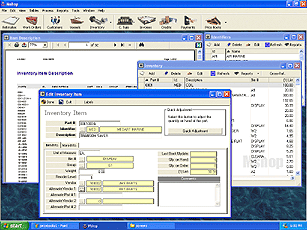|
|
 |
INVENTORY |
| |
Included
in
MShop
program
is a
powerful,
yet
simple,
inventory
control
system.
It
allows
you
to
maintain
accurate
records
on
inventory
sales
and
receipts.
Inventory
quantities
will
be
automatically
adjusted
when
you
sell
parts
using
Work
Orders,
Debit
Memos
and
Counter
Sales
(invoices).
The
inventory
file
will
also
be
automatically
adjusted
when
you
issue
credits
on
returns
by
using
MShop©'s
Credit
Memos.
Manual
inventory
adjustments
are
also
available.
You
may
add
to
your
inventory
any
parts
that
you
normally
stock,
as
well
as
items
that
you
rarely
sell
(such
as
special
orders).
This
way
you
will
have
a
more
detailed
history
of
all
items
sold
stored
in
your
computer. |
| |
|

[Click to enlarge] |
Add Items from Price Books
This option may be the fastest and easiest way of starting
your inventory file. Inventory items are automatically
transferred from the MShop Price Books to your inventory
file including: Part #, Part Identifier, Description, List
price and Cost.
Using this method also ensures that the inventory item
numbers matches the price book item number and that your
inventory prices will be updated correctly when new price
books are installed and the optional Update Inventory Prices
utility is ran.
|
|
| |
Inventory Orders and Receipts
The Inventory Order and Inventory Receipts feature allows
you to track multiple items ordered by vendor and to group
them into your own purchase orders.
The Inventory Orders and Inventory receipts will update the
inventory Qty. On Order which prints in the Items on Order
report. You can order several items in one inventory order
(Purchase Order). The inventory receipts allows to receive
full or partial inventory items receipts. They will update
the Qty. on Hand in your inventory table.
Inventory Adjustments
MShop does not allow you to manually modify the inventory
quantity on-hand. All inventory stock updates are
automatically made by the program, either deducting from
your inventory the items sold in Work Orders, Invoices or
Counter Sales, or adding to your inventory items received
using Inventory Orders and Receipts, or returns issued by
Credit Memos.
Sometimes, however, your inventory file may not match your
actual physical stock count. This may be due to posting
errors during inventory receipts or lost or stolen items. In
order to adjust your inventory count use the Inventory
Adjustments function. Inventory adjustments are immediately
posted and a record history of the adjustment, including the
adjustment comments, is stored for future reference.
|
|
Add Items from Huggins Cross Reference©
You may add items to your inventory directly from the
Huggins Cross-References© program. Adding items
using the cross-references ensures that the inventory item
number matches the price book item number and that your
inventory prices will be updated correctly when new price
books are installed and the optional Update Inventory Prices
utility is ran.
Add Items on the Fly
You may enter inventory items in Work Estimates, Work Orders
and Debit Memos (Invoices) and Inventory Orders that have
not yet been established in your inventory file. MShop will
automatically add these items to your inventory file.
Costing Method
MShop uses the average cost method to determine the value of
your inventory. The average cost of an inventory item is the
total cost of the items currently in stock divided by the
number of items in stock. MShop recalculates the average
cost of an item every time you record the purchase of
additional units of the item. It adds the cost of the new
item(s) to the cost of the old stock and then divides by the
total number of new and old items. |
|
|